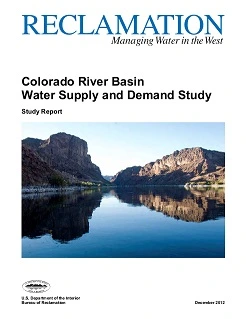Public Policy Review

In December 2012, the U.S. Department of Interior released the Colorado River Basin Water Supply and Demand Study, with officials referring to it as a “Call to Action”. This massive study, which can be accessed from the web site of the U.S. Bureau of Reclamation, was three years in the making. It involved a diverse set of partners and stakeholders from the seven Colorado River Basin states, many of whom contributed significantly to the data and analyses. Its Executive Summary and 89-page Study Report summarize the effort’s methodology and findings. The Executive Summary states: “The purpose of the study was to define current and future imbalances in water supply and demand in the Basin and the adjacent areas of the Basin States that receive Colorado River water over the next 50 years, and to develop and analyze adaptation and mitigation strategies to resolve those imbalances.” Most notably, it then states that the study did not propose a set of solutions but rather “a common technical foundation that frames the range of potential imbalances that may be faced in the future and the range of solutions that may be considered to resolve those imbalances.”
The Study Report does a nice job of explaining potential scenarios and their resulting imbalances and summarizing the options for addressing the imbalances, with costs, time frames, and potential water yields noted. The list of solution options is, by and large, not surprising. Some commentary has focused on the very expensive and costly water importation options. However, the cost, legal, political and environmental feasibility challenges of a few of the options are well recognized.
Some have noted that the report documents what we already know. We know that the Colorado River Compact allocations were based on a wet period and that average flows are expected to be lower than the commitments, if we can call them that, of water. Dry periods may be more severe than even the tree ring records suggest due to changes in climate. We know the population and economies of the regions served by Colorado River water have grown and will continue to grow. We know that the economies of some regions, such as Central Arizona, are more vulnerable to Colorado River shortage than others. We know that water utilization and precipitation patterns affect the water demanded by and available to all of the water using sectors – municipal, agricultural, industrial and natural.
The water management challenges of the region have been well studied and documented. Almost 20 years ago, in 1995, the American Water Resources Association published a special issue of Water Resources Bulletin. Entitled Severe and Sustained Drought: Managing the Colorado River System in Times of Water Shortage, the 13 collected papers cover the following topics: tree ring records, hydrologic scenarios, drought impacts, legal and institutional options, social implications, environmental effects, competition for water resources and valuing drought damages, hydrologic and economic impacts of drought under alternative policies, and mitigating impacts. The volume’s introductory article by Robert A. Young notes that solution options were divided into three groups: “those pertaining to operating rules presently in effect; those pertaining to potential changes in existing rules; and those which pertain to the feasibility of making such changes via negotiation, litigation, or legislation.” Young’s article concludes with acknowledgement of the following limitations: “Because of the large geographic scale, the technical complexity of the problem, and the limited resources and time available to the research team, the results must be considered as partial and tentative.” Young acknowledged that the broad effects of inadequate precipitation and environmental impacts could not be addressed as well as the authors would have liked, and measures of water demand were generalized based on local data. In 1995, however, the publication represented a comprehensive summary of the state of knowledge.
In the intervening 20 years, the region has grown significantly. Institutional arrangements not anticipated, such as interstate banking, have been enacted. The Colorado River Interim Guidelines for Lower Basin Shortages and Coordinated Operations for Lake Powell and Lake Mead and the Interim Shortage Sharing Guidelines were adopted in 2007. Minute 319 to the 1944 U.S.-Mexico Water Treaty, which was signed in November 2012, agrees for a five year period to share water shortages and surpluses across the border. We are adapting to a changing and uncertain landscape – or should I say waterscape – but all recognize that we must do more.
Let’s embrace the study as a Call to Action. The study involved many partners, public and private. It was subject to external peer review. It projects 3.2 million acre-feet (3,947 million cubic meters) as the imbalance between water supply and water demand in the study area by 2060. Of course, the 3.2 million figure is only an estimate, and we know that projections are usually wrong – especially those 50 years out. The actual imbalance may be lower or it may be higher. The debate should not be on the figure but on what we do to prepare ourselves. If it turns out that we unexpectedly enter a very wet period and we have over-prepared, we can all congratulate ourselves – or others can congratulate us posthumously – on what an excellent job we did of water management. However, if we do not take action now to develop the strategies to addressing imbalances, we will have failed doing for future generations what past generations have done for us, namely identifying the path(s) to water security.

